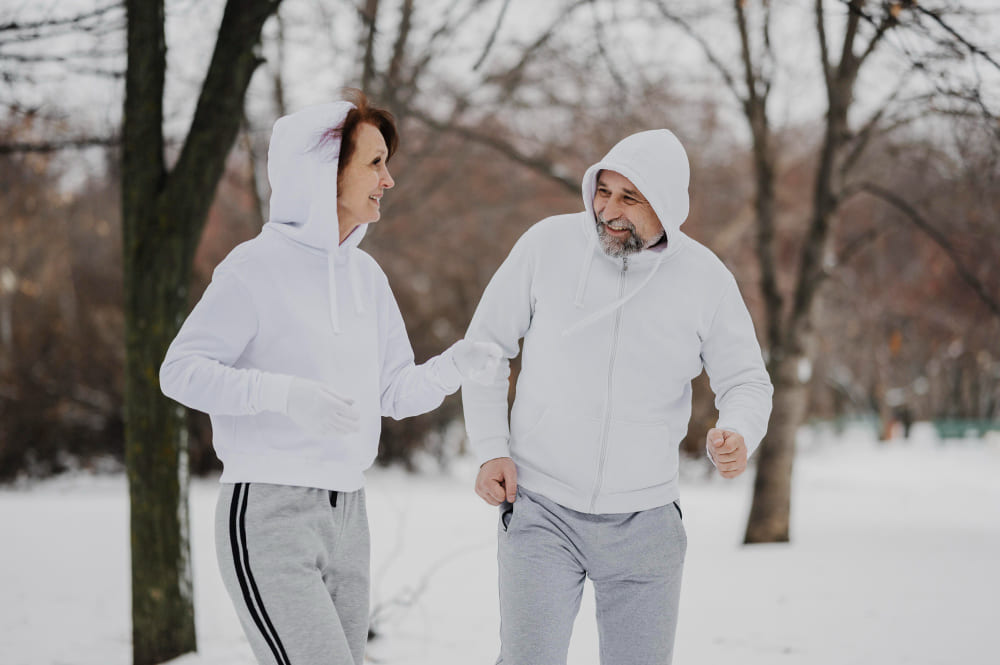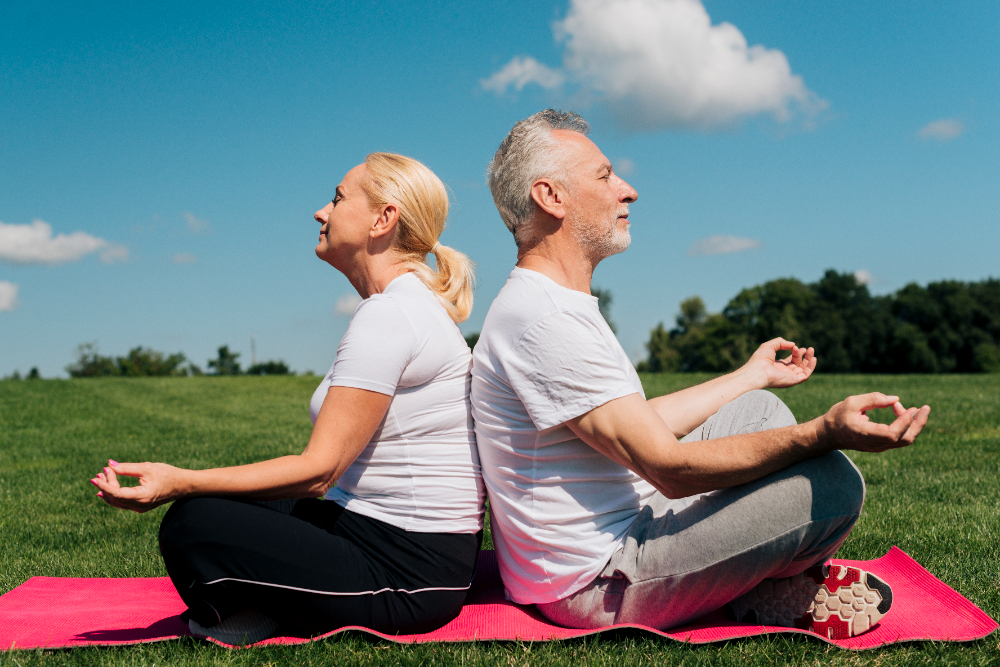Winter brings shorter days, colder temperatures, and, in many cases, less energy to stay active. However, exercising during this season is crucial, especially for people over 50. Staying active not only helps take care of the body but also strengthens the mind and improves mood.
Physical Benefits
- Strengthening muscles and joints: In the cold, it’s common for joints to feel stiffer. Regular exercise improves flexibility, reduces discomfort, and prevents muscle mass loss, which is more common with age.
- Improving circulation: Physical activities like walking, stretching, or practicing yoga at home help maintain good blood circulation, combat the cold, and reduce the risk of cardiovascular disease.
- Weight control and metabolism: Exercise helps balance metabolism, which tends to slow down with age and reduced activity during winter.
Mental Benefits
- Reducing stress and anxiety: During winter months, many people experience increased stress or melancholy. Exercise releases endorphins, the “feel-good hormones,” which improve mood.
- Preventing winter depression: The lack of sunlight can affect serotonin levels in the brain, causing what’s known as Seasonal Affective Disorder (SAD). Physical activity counters this effect, helping regulate mood.
Emotional Benefits
- A sense of achievement and well-being: Maintaining an active routine, even with simple home exercises, fosters a sense of control and satisfaction. Every small step counts, and daily effort has a positive impact on self-esteem.
- Strengthening personal connections: Sharing your routines with a loved one, even virtually, can turn exercise into a moment to connect and motivate each other.
How to Create an Ideal Space for Exercising at Home
Exercising at home during winter can be comfortable and effective if you prepare the right space. You don’t need a home gym or expensive equipment; with a small area and a few basic items, you can create the perfect environment to stay active.
1. Find a Functional Corner
Choose a quiet, well-lit spot where you can move comfortably. It could be a corner of your living room, bedroom, or even a hallway. Make sure it’s spacious enough for movements like stretching or strength exercises.
- Clear away objects that might obstruct your movements or pose a tripping hazard.
- Use a non-slip mat if the floor is slippery.
2. Keep Everything Within Reach
Organize the equipment you need for your exercise routine in an accessible place. A small drawer, box, or corner of a closet can be ideal for storing your gear.
3. Basic Equipment to Get Started
You don’t need large machines to work out. These items are affordable, take up little space, and are ideal for home routines:
- Mat or exercise mat: Perfect for yoga, Pilates, or stretching exercises.
- Resistance bands: Versatile for strengthening muscles without putting too much pressure on the joints.
- Light dumbbells: Great for strength and toning exercises. If you don’t have them, water bottles or bags of rice can be good substitutes.
- Stability ball: Useful for improving balance and strengthening your core.
- Sturdy chair: Can be used for support during balance exercises or assisted squats.
4. Customize Your Space
- Add comfort: Place a towel or cushion if you need extra support for your knees or neck.
- Incorporate technology: If you use an app like Sensalus, keep your device nearby to follow guided routines.
- Control the environment: Maintain a comfortable temperature and use music or relaxing sounds to stay motivated.
5. Adapt Your Space to Your Needs
If your home is small, don’t worry. Routines can be adjusted to what’s available. Many activities on Sensalus are designed to be done in limited spaces, with simple and effective movements that don’t require much room.
Creating an ideal space not only makes exercising easier but also motivates you to stay consistent. Your activity corner could become your favorite spot at home, even during the coldest months.
Easy Home Routines for Winter
With simple and effective exercises, you can strengthen your body, improve your cardiovascular health, and stay flexible without advanced equipment. Here’s a complete routine ideal for people over 50.
1. Warm-Up: Prepare Your Body for Movement
Warming up is essential to avoid injuries and prepare your muscles and joints for exercise. Dedicate 5-10 minutes to these gentle movements:
- Marching in place: Lift your knees slightly and move your arms.
- Shoulder circles: Rotate both shoulders forward and then backward for 30 seconds.
- Waist twists: Gently twist your torso from side to side with your hands on your waist.
- Heel-to-glute: Alternate lifting your heels toward your glutes while bending your knees.
2. Strength Routines Using Body Weight
Strength exercises are key to preventing muscle loss and strengthening bones and joints. Perform 2-3 sets of 10-15 repetitions of these exercises:
- Assisted squats: Use a chair for support. Sit and stand slowly, keeping your back straight.
- Inclined push-ups: Place your hands on a wall or sturdy furniture and perform push-ups with your body inclined.
- Glute bridge: Lie on your back with knees bent and feet flat. Lift your hips toward the ceiling and lower them slowly.
- Heel raises: Stand while holding onto a chair, lifting your heels off the ground slowly to strengthen calf muscles.
3. Cardio Exercises Without Leaving Home
Cardio improves heart health, helps maintain a healthy weight, and boosts energy levels. Spend 10-15 minutes on activities like:
- Quick marching in place: Alternate between moderate walking and speeding up for 30 seconds.
- Side steps with claps: Step laterally from side to side, clapping your hands as you switch directions.
- Step-ups: Use a secure step or platform to step up and down, alternating feet.
- Dancing: Play your favorite music and dance for a few minutes—it’s a fun way to exercise.
4. Stretching to Finish
Stretching helps relax muscles and improve flexibility. Dedicate 5-10 minutes to these movements:
- Back and arm stretch: Sit in a chair, stretch your arms forward, and round your back slightly.
- Leg stretch: Place one foot on a chair and stretch your leg, leaning forward gently.
- Neck rotation: Slowly turn your neck from one side to the other, avoiding sudden movements.
- Child’s pose (yoga): Sit back on your heels, stretch your arms forward, and relax your torso toward the floor.
Tips to Stay Motivated to Exercise During Winter
Winter can test your motivation, but establishing consistent habits and using practical strategies can make all the difference. Here are some tips to stay active, even during the colder months:
- Set a Routine: Treat your exercise time as an essential appointment.
- Set Small Goals: Focus on achievable targets, like 10 minutes of exercise daily.
- Find Activities You Enjoy: Whether it’s dancing, yoga, or Pilates, do what makes you happy.
- Use Resources: Sensalus offers guided routines tailored to your needs, helping you stay active at home.
- Reward Yourself: Celebrate milestones with small rewards, like a cup of tea or a new workout mat.
Final Note from Sensalus
At Sensalus, we’ve created tailored exercise routines to help you stay active and motivated during the winter. With guided content and adaptable plans, our app is your ideal partner for a healthy and balanced lifestyle from the comfort of your home.








